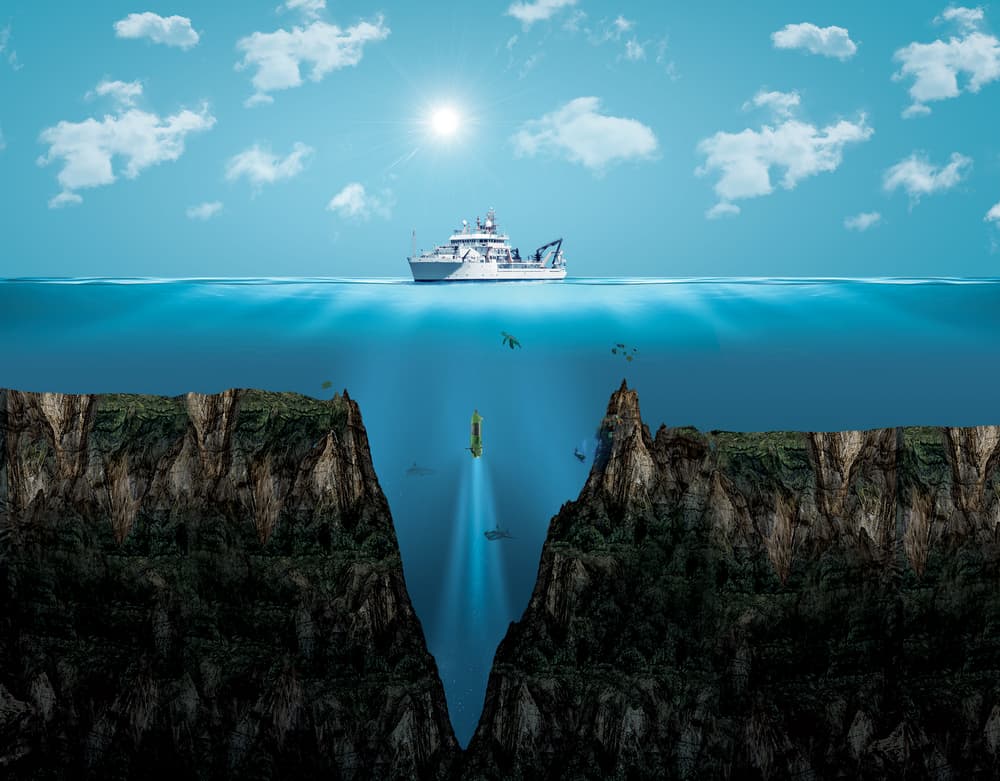↓ Continue Reading To See This Amazing Video
The Mariana Trench is the ocean’s deepest point. The trench runs more than 1,500 miles long and stretches across a Western strip of the Pacific Ocean south of Japan and north of Papua New Guinea. The Mariana Islands are the trench’s namesake, sitting on a piece of the western ridge.
At its widest, the Mariana Trench is 44 miles across and could encompass the earth’s largest canyon more than 100 times over. The lowest point in the trench is also the lowest point of the entire ocean, known as the Challenger Deep.
We’ll look at the Mariana Trench, uncovering its origins, history, and some of the interesting life forms that call it home.
The Challenger Deep
The lowest point in the Mariana Trench, the Challenger Deep, is just under 36,000 feet deep. That’s roughly 6.7 miles.
You’ll often hear people describe the magnitude of the Challenger Deep by saying “you could fit Mount Everest inside of it.” You could, in fact, fit the 29,032-foot Everest into this pit and have more than a mile left over.
It’s nearly impossible to imagine the scope of a trench this deep. Even if you were to take a submarine down to its bottom, you would be submerged in the blackness of a place so deep that light could never reach it. Light penetrates as far as 1,000 meters into the ocean under the right conditions, but the Challenger Deep sinks down more than 10,000 meters.
So, we have to appreciate the trench in a very conceptual way. It’s impossible to take photographs of the terrain down there, apart from narrow images snapped with the help of bright underwater lights.
In many ways, the depth of the Mariana Trench outstretches our ability to document and understand its terrain. That’s part of what makes it so mysterious—there’s still so much to discover.
That incredible depth formed when two of the earth’s plates converged. The Mariana plate slid eastward and rode over the Pacific Plate which was directed downward. The two plates are still driven together at the rate of a few inches per year.
As the Pacific Plate is pressed downward, the material furthest down melts and turns to magma. That magma pushes upward and erupts in volcanos in the sea. As eruptions compound, the magma builds and forms islands.
This volcanic activity is what formed the Mariana Islands on the trench’s western ridge, the most famous of which is Guam.
The First Explorations
The Mariana Trench was first measured in 1875 during the Challenger expedition, which used the method of sounding. “Sounding” is a method of measuring the depth of a body of water and typically involves a long, weighted rope.
It doesn’t involve the use of sound or radar, as the name would suggest. Rather, this ancient depth-finding method involves notches on a rope or other rudimentary measurements to estimate depth. The depth at which the weighted rope hits bottom
The first measurement of the trench came in at 26,850 feet.
The Challenger Deep was first measured using echo sounding in 1951, and the recorded depth at that time was 35,760 feet. In 2009, a sonar multibeam bathymetry system recorded a depth of 35,994 in Challenger Deep, and that is the current record.
The Challenger Deep was first reached by Jaques Piccard and Don Walsh, an oceanographer and Navy Lieutenant, respectively. The two men sunk in for more than five hours in a vessel called The Trieste. They reached the bottom on January 23rd, 1960.
©iStock.com/ratpack223
Life in The Trench
The barren conditions of the ocean at such a depth would seem incompatible with life. Still, scientists have found giant multinucleate unicellular organisms called xenophyophores as well as amphipods, clumps of microbes, and even fish.
The Mariana snailfish, for example, is believed to have the deepest habitat of any fish. It exists with no known natural predators and enjoys access to a bounty of invertebrate prey.
It’s also important to note that life forms at this depth are not immune to human impact. The Mariana Trench, as magnificent and mysterious as it may be, is still something of a funnel for human waste. The organisms in the Mariana Trench are impacted by these pollutants for generations, considering that many pollutants do not break down naturally.
So, the floor of the Mariana Trench is a peculiar blend of alien-like terrain, unfamiliar life forms, and human waste. Few individuals have experienced that world, but there’s a lot of video footage of the trench including James Cameron’s Deepsea Challenge.
